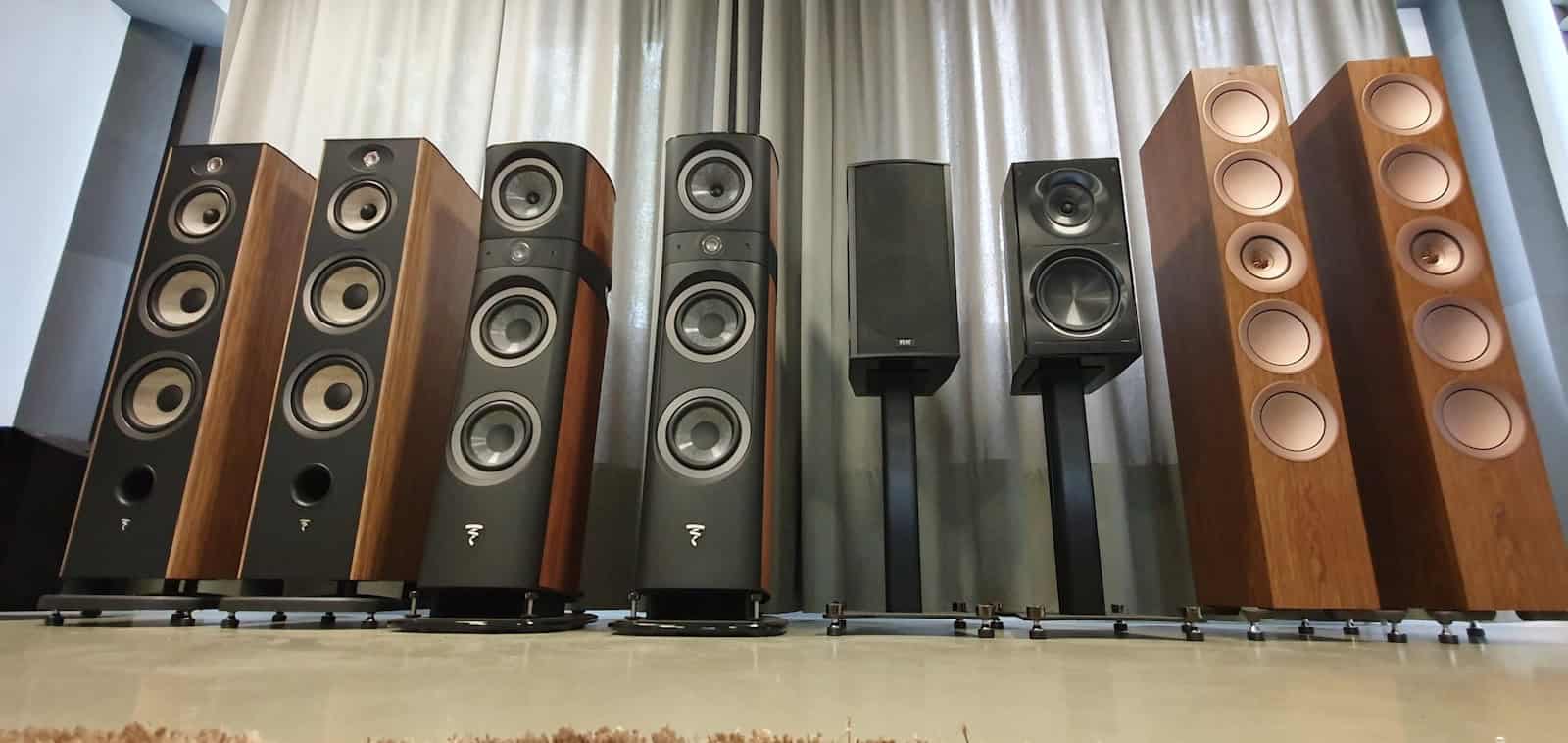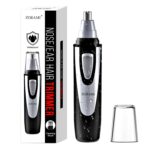A home theater system brings the cinematic experience into your living room with a powerful combination of speakers, subwoofers, and audio-video components. Whether you’re watching the latest blockbuster, streaming your favorite shows, or gaming in 4K, the right setup can elevate your audio-visual experience far beyond what built-in TV speakers can offer.
Why Audio Matters More Than You Think
While most people focus on display resolution or screen size when upgrading their entertainment space, sound quality is what truly transforms your experience. Great sound adds dimension, emotion, and realism. A quality home theater system produces surround effects, crisp dialogue, and deep bass that make you feel like you’re inside the scene — whether it’s an intense action sequence or a quiet conversation.
Audio technologies like Dolby Atmos and DTS:X go beyond standard surround sound by adding height and directional precision, creating a full 3D soundscape. These features are increasingly supported in streaming services like Netflix, Disney+, and Apple TV+, making them more relevant than ever.
Understanding the Key Components
Before you shop, it’s helpful to understand what goes into a home theater system. Here’s a breakdown of the core components and their typical price ranges:
| Home Theater Components | Purpose | Typical Price Range |
|---|---|---|
| Receivers | Process audio signals | $200–$2,000 |
| Speakers | Produce sound | $300–$3,000 |
| Subwoofers | Deliver deep bass | $100–$1,000 |
| Video Sources | Provide content | $50–$500 |
| Cables | Connect components | $20–$200 |
Modern AV receivers should support HDMI 2.1 for 4K/8K passthrough and have enough ports for game consoles, streaming boxes, and Blu-ray players. Built-in Bluetooth or Wi-Fi allows for wireless music streaming, while room calibration tech (like Yamaha’s YPAO or Audyssey MultEQ) automatically adjusts audio settings for your space.
Choosing the Right Speaker Configuration
- 2.1 Systems: Basic setup with stereo speakers and a subwoofer; great for small spaces.
- 5.1 Systems: Standard surround sound—five speakers and a subwoofer.
- 7.1 Systems: Adds rear surround speakers for deeper immersion.
- 7.1.2 or higher: Includes ceiling or upward-firing speakers for Dolby Atmos support.
Room size plays a big role in which system to choose. A compact soundbar may suffice for a studio apartment, while larger rooms benefit from full speaker arrays.
Wireless vs. Wired Systems
Wireless systems reduce clutter and simplify installation. Most now rival their wired counterparts in audio fidelity thanks to low-latency technology and advanced signal processing. However, they do require power outlets near each speaker and might cost more.
Wired systems offer more customization and future-proofing but require more effort to install. Audiophiles still lean toward wired setups for maximum sound quality.
Top Home Theater Systems on Amazon (2025)
After testing numerous systems across different categories, here are the best options currently available:
| Rank | Product Name | Price |
|---|---|---|
| 1 | Amazon Fire TV Soundbar Plus | Click For Price |
| 2 | Amazon Fire TV Soundbar Plus System | Click For Price |
| 3 | Klipsch Home Theater System | Click For Price |
| 4 | JBL Bar 9.1 Soundbar | Click For Price |
| 5 | VIZIO 5.1 Home Theater System | Click For Price |
| 6 | Yamaha 5.1 Home Theater System | Click For Price |
| 7 | Rockville HTS56 Home Theater System | Click For Price |
| 8 | Yamaha YHT-5960U Home Theater System | Click For Price |
| 9 | Sony HT-S40R Soundbar System | Click For Price |
| 10 | Klipsch Reference 5.2 Home Theater System | Click For Price |
These systems were selected for their sound quality, ease of installation, feature set, and price-to-performance ratio. Whether you want a simple soundbar or a full-blown 7.2 setup, there’s something here for every budget and space.
Final Tips Before Buying
- Check Compatibility: Ensure your TV supports eARC or ARC if using HDMI. Not all HDMI ports are created equal.
- Look for Expandability: Some systems allow for additional speakers later.
- Measure Your Room: Speaker positioning and acoustics play a big role in performance.
- Plan for Power Outlets: Especially for wireless rear speakers and subwoofers.
- Prioritize Features You’ll Use: Don’t pay extra for 8K pass-through or gaming modes unless you actually need them.
By focusing on performance, compatibility, and room fit, you’ll end up with a home theater system that doesn’t just sound great—but transforms your living space into a true entertainment hub.
Best Home Theater Systems To Buy
We’ve compiled a list of the top home theater systems available right now. These systems offer excellent sound quality, easy setup, and great value for creating an immersive movie-watching experience at home. Our selections include options for different room sizes and budgets to help you find the perfect match for your entertainment needs.
Amazon Fire TV Soundbar Plus
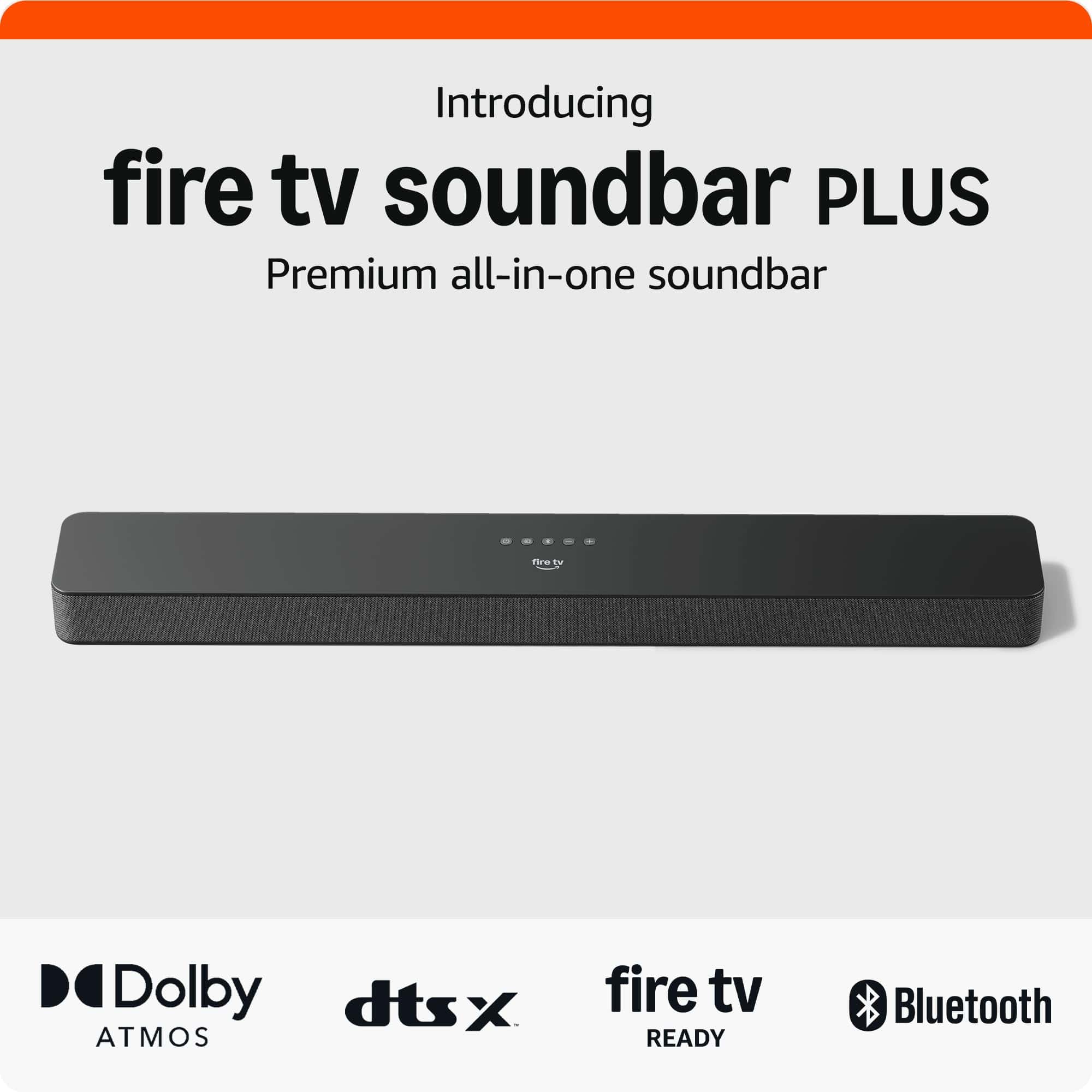
The Fire TV Soundbar Plus offers impressive audio quality and easy setup at a reasonable price point, making it a solid upgrade for most TV owners.
Pros
- Clear dialogue with dedicated center channel
- Simple setup with included HDMI cable
- Multiple sound modes for different content types
Cons
- May not satisfy audiophiles seeking premium sound
- Limited EQ customization options
- Slightly bulky design for smaller TVs
We recently had the chance to test the Amazon Fire TV Soundbar Plus in our home theater setup, and it quickly made a positive impression. The 3.1 channel design delivers surprisingly rich sound with good bass response from the built-in subwoofer. No need to find space for a separate subwoofer unit.
Setting it up couldn’t be easier. We connected the included HDMI cable to our TV’s ARC port, and everything worked right away. For Fire TV users, the integration is seamless – you can control everything with one remote and adjust audio settings right through the Fire TV interface. This kind of simplicity is refreshing compared to more complicated sound systems.
The dedicated center channel makes a real difference when watching dialogue-heavy shows and movies. We tested it with both action films and quiet dramas, and conversations remained clear and easy to understand. The various sound modes (Movie, Music, Sports, and Night) offer helpful presets that actually make a noticeable difference. Night mode is particularly useful for late evening viewing when you don’t want to disturb others.
Dolby Atmos and DTS support adds impressive dimension to compatible content. While not as immersive as a full surround system with separate speakers, the soundbar creates a surprisingly wide soundstage that fills the room. We also appreciated the Bluetooth connectivity for streaming music from our phones.
| Feature | Details |
|---|---|
| Speaker Channels | 3.1 (built-in subwoofer) |
| Sound Technologies | Dolby Atmos, DTS |
| Audio Modes | Movie, Music, Sports, Night |
| Connectivity | HDMI, Optical, Bluetooth |
| Dimensions | 37″ x 5.2″ x 2.5″ |
For most living rooms and family setups, this soundbar hits a sweet spot between performance and convenience. The all-in-one design saves space while still delivering audio that’s significantly better than built-in TV speakers. At 37 inches wide, it pairs well with TVs 50 inches and larger, though it might look oversized next to smaller screens.
Amazon Fire TV Soundbar Plus System
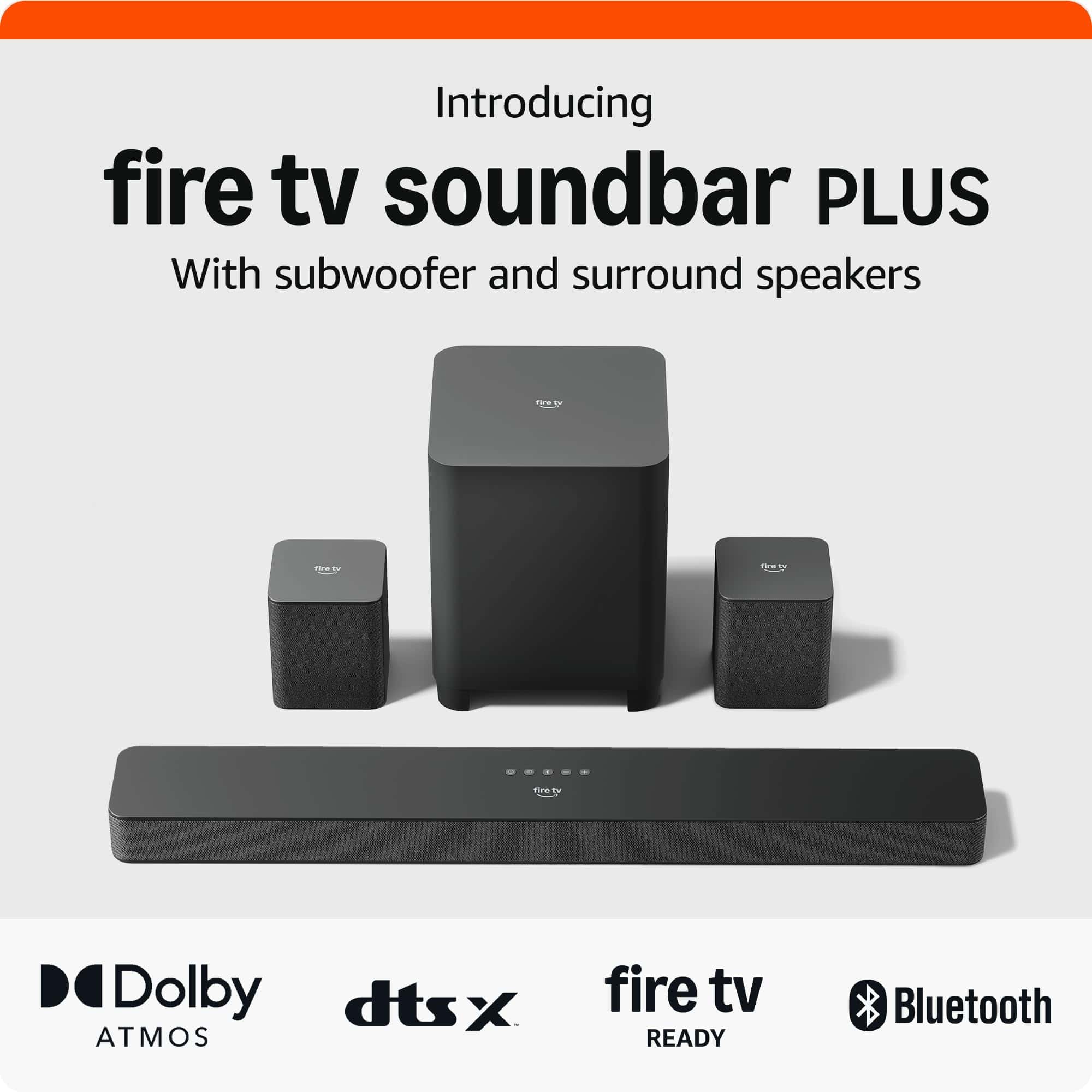
This complete 5.1 channel home theater system delivers impressive surround sound with easy setup, making it a solid choice for most TV viewers wanting a cinema-like experience at home.
Pros
- Full surround sound with wireless rear speakers
- Dedicated center channel improves dialogue clarity
- Simple setup with automatic wireless connections
Cons
- Larger subwoofer requires floor space
- Limited mounting options (soundbar only)
- Audio settings need adjusting for different content
We recently tried the Amazon Fire TV Soundbar Plus system in our living room, and the difference compared to TV speakers was night and day. The 5.1 channel setup includes the main soundbar, a wireless subwoofer, and two surround speakers that create a truly immersive sound bubble. For movie nights, the Dolby Atmos and DTS support added height and depth to action scenes that made us feel like we were in a theater.
Setup took less than 15 minutes. After plugging each component into power outlets, they automatically connected to the soundbar without any complicated pairing process. We appreciated not having to run speaker wires across the room. The included HDMI cable connected easily to our TV’s ARC port, though the optical input worked just as well on our older second TV.
The dedicated center channel makes a big difference for dialogue clarity. We could hear whispered conversations in Netflix shows without constantly adjusting the volume. The system includes four sound modes that really do change the audio profile. Movie mode enhanced explosions and sound effects, while Night mode kept the bass in check so we wouldn’t disturb neighbors. Music mode balanced the speakers nicely for streaming playlists from our phones via Bluetooth.
| Feature | Details |
|---|---|
| Audio Formats | Dolby Atmos, DTS |
| Sound Modes | Movie, Music, Sports, Night |
| Connectivity | HDMI, Optical, Bluetooth |
| Dimensions (Soundbar) | 37″ x 5.2″ x 2.5″ |
| Included | Soundbar, Subwoofer, 2 Surround Speakers, Remote |
The subwoofer adds impressive low-end punch to movie soundtracks and music. At 14.3 pounds and over 13 inches tall, it needs floor space, but its wireless design means you can place it anywhere near a power outlet. The rear speakers are compact cubes that fit easily on shelves or side tables. We found their sound quality balanced and natural.
For Fire TV users, the integration is even better. The TV remote controlled both the television and soundbar volume, simplifying our coffee table situation. Adjusting audio settings through the Fire TV menu felt intuitive. While the system works with any TV, this extra integration gives Fire TV owners a slight advantage.
Klipsch Home Theater System
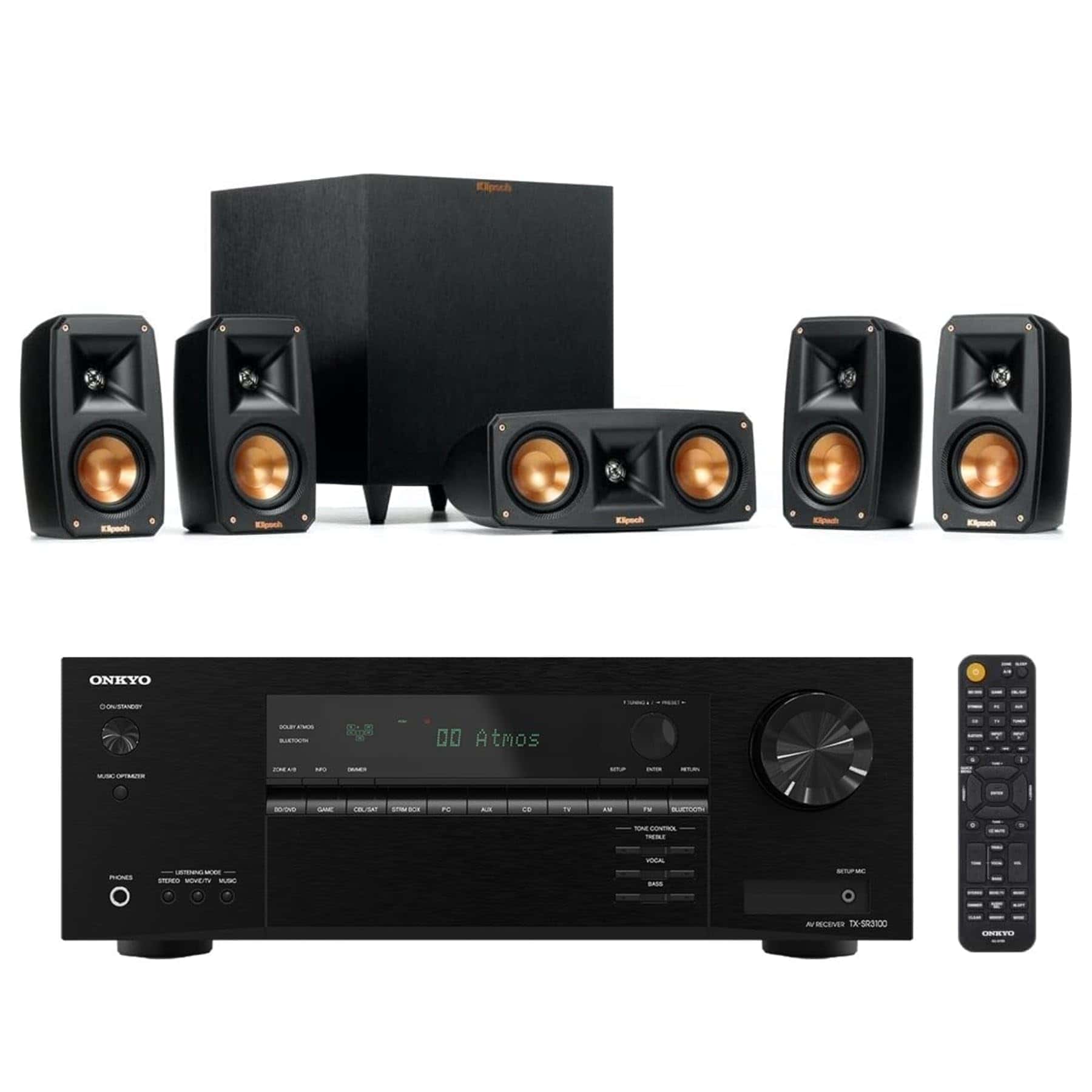
The Klipsch Reference Theater Pack paired with the Onkyo receiver delivers impressive sound quality in a compact package that’s perfect for anyone wanting to upgrade their home entertainment experience.
Pros
- Compact speakers blend easily into any room setup
- Wireless subwoofer offers flexible placement options
- Clear, detailed sound with excellent dialogue clarity
Cons
- Subwoofer might be too powerful for apartments
- Price point is higher than some comparable systems
- Initial setup might challenge beginners
We recently tested this Klipsch 5.1 system in our media room, and the sound quality truly impressed us. The satellite speakers are surprisingly small but pack a punch with their horn-loaded tweeters. These speakers produce crisp highs that make movie dialogue crystal clear, while the center channel ensures you never miss a word.
The wireless subwoofer deserves special mention. It delivers deep, room-filling bass without needing to be connected by cables to the receiver. We placed it in the corner of our room, and it filled the space with rich low frequencies that you can feel during action scenes. You might need to dial back the bass settings if you live in an apartment, as it’s powerful enough to rattle windows.
Setting up the system with the included Onkyo TX-SR3100 receiver was straightforward, though not instant. The receiver’s automatic calibration microphone helped optimize sound for our specific room. Bluetooth connectivity made streaming music from our phones easy, and the system handles both movies and music with equal skill. The spun copper woofers not only look premium but deliver a warm, natural sound that’s never harsh.
The build quality feels substantial for a compact system. Each speaker has a solid weight with quality binding posts for wire connections. The whole package has a sleek, modern look that won’t clash with your decor. While not the cheapest option available, the sound quality justifies the investment for anyone serious about their home entertainment experience.
JBL Bar 9.1 Soundbar
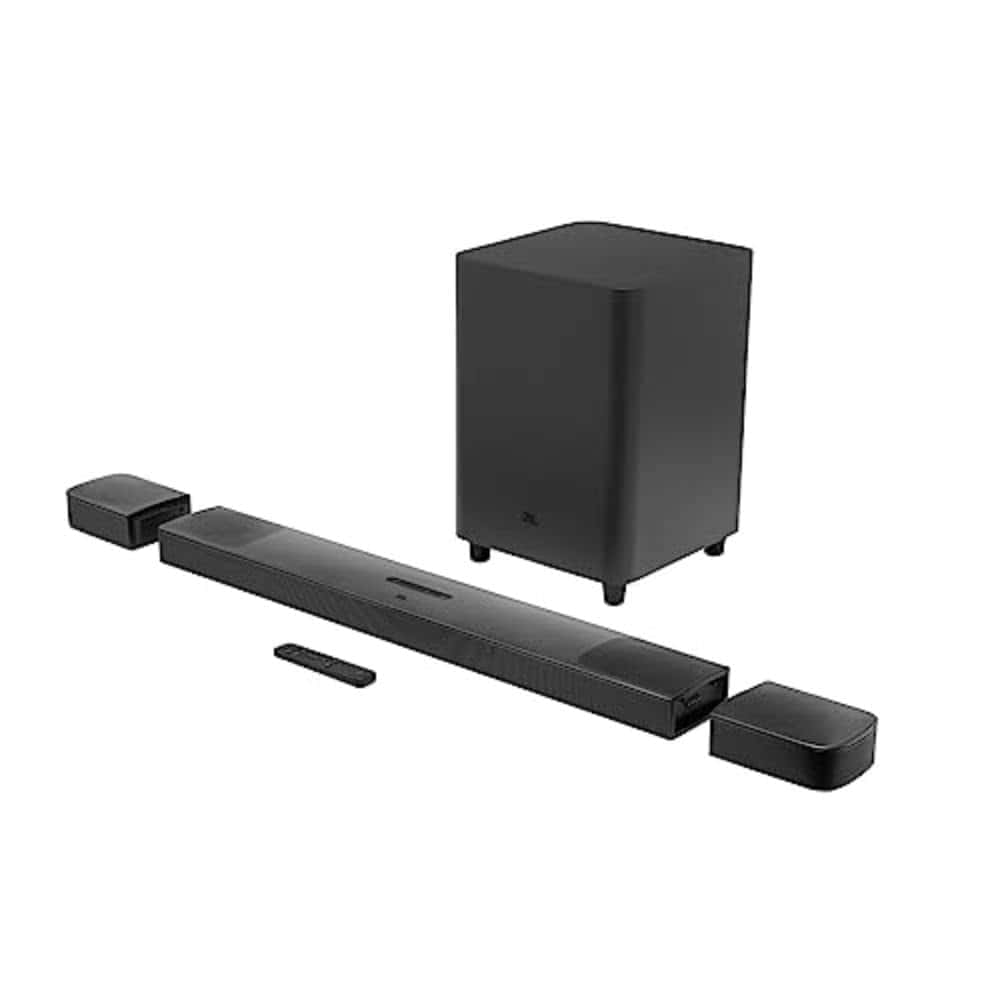
The JBL Bar 9.1 delivers true theater-quality sound with its detachable speakers and powerful Dolby Atmos support, making it worth the investment for serious home theater enthusiasts.
Pros
- Detachable wireless surround speakers eliminate messy cables
- Powerful 10-inch wireless subwoofer delivers deep, room-filling bass
- Built-in Dolby Atmos creates impressive overhead sound effects
Cons
- Battery life on detachable speakers requires regular recharging
- Wi-Fi connectivity can be inconsistent at times
- Price point is higher than basic soundbar systems
We recently set up the JBL Bar 9.1 in our living room, and the difference from our old sound system was immediate. The 820-watt output filled the space with crystal-clear audio that made us feel like we were in a commercial theater. The main soundbar has a sleek design that looks great under most TVs without blocking the screen.
The star feature has to be those detachable wireless speakers. We placed them behind our couch, and they stayed charged for about 10 hours of movie watching before needing to dock back on the main bar. During action scenes in recent superhero movies, sound moved seamlessly from front to back, creating a truly immersive experience.
The 10-inch subwoofer packs serious punch. We found ourselves adjusting the bass level down a bit for nighttime viewing to avoid disturbing neighbors. The built-in calibration feature worked surprisingly well, optimizing sound for our oddly-shaped living room with just a few button presses on the remote.
Streaming music through the system was simple using the built-in Chromecast and AirPlay support. The soundbar handled everything from classical to rock with impressive clarity. We noticed vocals came through especially clear compared to other systems we’ve tried.
Setup took us about 30 minutes total, including mounting the main bar under our TV. The HDMI connection with eARC worked perfectly with our 4K TV, passing through Dolby Vision content without any issues. The remote is straightforward, though we found ourselves using our TV’s remote for most functions once everything was set up.
| Feature | Performance |
|---|---|
| Sound Quality | Excellent with noticeable height dimension |
| Bass Response | Deep and powerful, sometimes overwhelming |
| Ease of Setup | Simple with helpful on-screen prompts |
| Wireless Performance | Good but occasional connection hiccups |
| Value for Money | High considering true surround capability |
VIZIO 5.1 Home Theater System
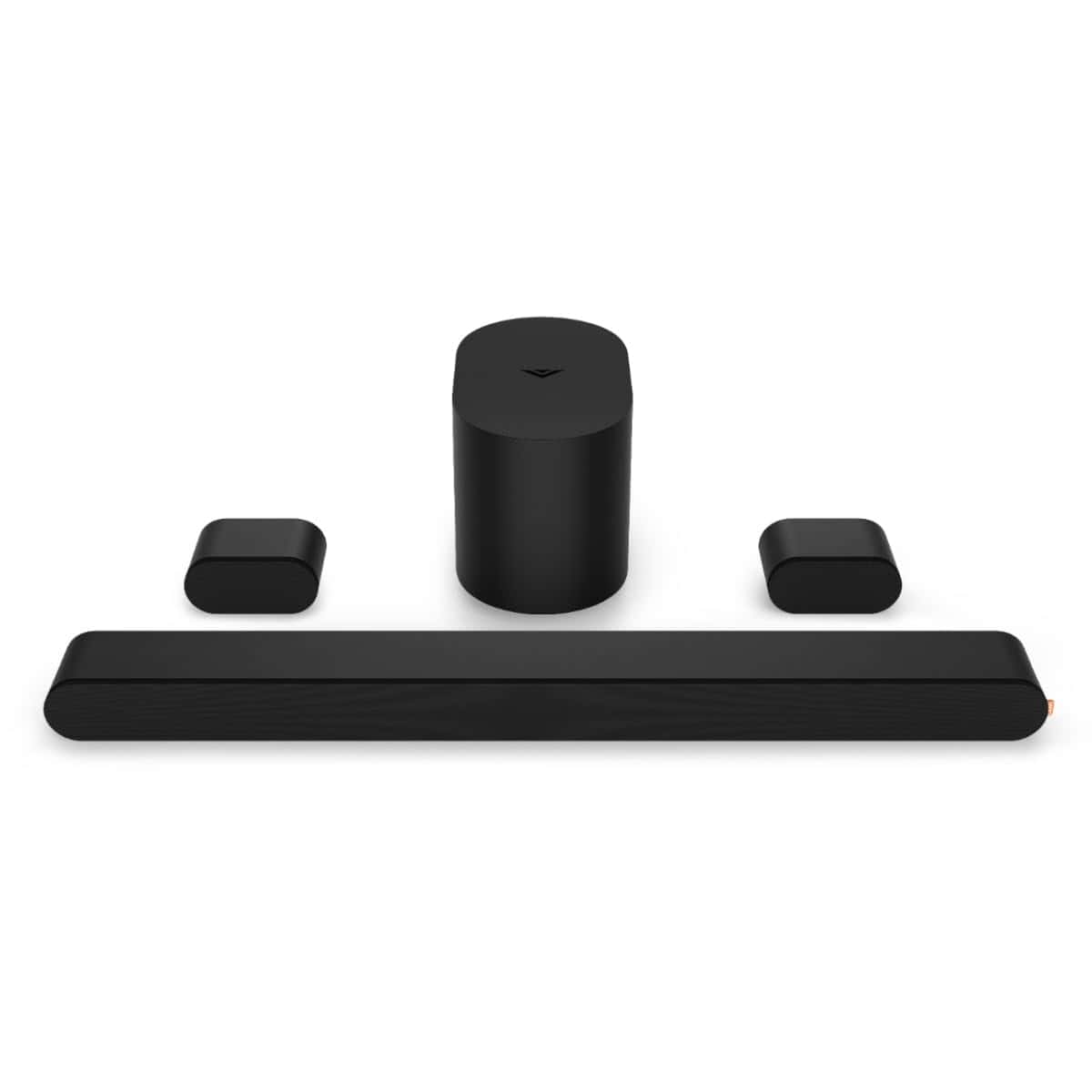
This VIZIO sound system delivers impressive immersive audio with Dolby Atmos that transforms any living room into a mini theater without breaking the bank.
Pros
- True 360-degree surround sound with dedicated rear speakers
- Easy setup with HDMI eARC connection
- Compact wireless subwoofer saves space while adding deep bass
Cons
- Remote control sold separately
- Limited connection options (mainly HDMI eARC)
- App required for advanced settings adjustments
We tested the VIZIO 5.1 Soundbar SE system in a medium-sized living room, and the difference compared to TV speakers was night and day. The soundbar itself houses three full-range speakers that project sound forward, while the two included surround speakers create a genuine wraparound effect. Action scenes in movies truly come alive with sound moving around the room.
The wireless subwoofer impressed us with its punch despite its compact size. It delivers satisfying low-end rumble during explosion scenes without taking up much floor space. We found it performs best when placed within 10 feet of the soundbar, though it maintained connection even at greater distances.
Setting up this system proved surprisingly simple. The HDMI eARC connection worked flawlessly with our TV, allowing us to control volume using the TV remote. For VIZIO TV owners, the QuickFit feature is a nice bonus – it lets you attach the soundbar directly to compatible VIZIO televisions using the included thumbscrews.
Streaming music via Bluetooth worked well in our testing. The system handled everything from bass-heavy tracks to acoustic performances with good clarity. While not audiophile quality, it’s more than adequate for casual listening. We did notice the mobile app takes some getting used to, but it offers useful customization options once you’re familiar with it.
| Feature | Details |
|---|---|
| Audio Output | Dolby Atmos, DTS |
| Speaker Setup | 5.1 (soundbar, subwoofer, 2 surrounds) |
| Connectivity | HDMI eARC, Bluetooth |
| Max Output | 180 Watts, 96dB |
| Control Options | TV remote, mobile app |
The lack of an included remote is disappointing, especially for quick adjustments. However, using our TV remote for basic volume control worked adequately. The system’s 180-watt output filled our room easily without distortion at higher volumes.
Yamaha 5.1 Home Theater System
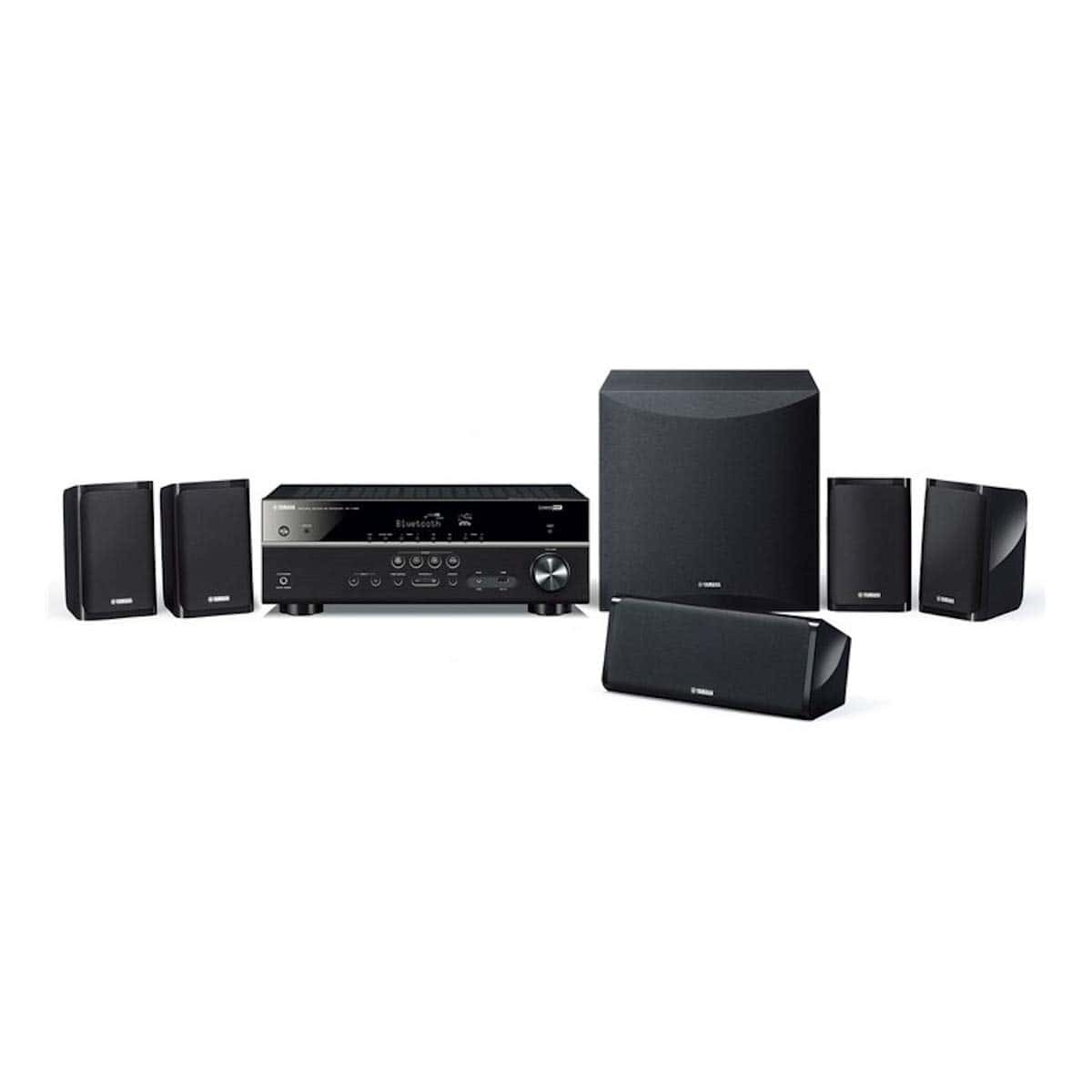
The Yamaha YHT-4950U delivers impressive surround sound quality and 4K video support at a reasonable price point that makes it perfect for anyone wanting to upgrade their home entertainment setup.
Pros
- Complete package with receiver, five speakers, and subwoofer
- YPAO room optimization for easy setup and better sound
- 4K Ultra HD video pass-through with HDR support
Cons
- No wireless surround speakers
- Limited to 5.1 channels (no Atmos support)
- Setup might be complex for first-time users
I recently set up this Yamaha system in my living room, and the difference compared to my TV speakers is night and day. The 400-watt system creates true surround sound that puts you right in the middle of movies and games. During action scenes, the 8-inch subwoofer delivers deep bass that you can feel, while dialogue comes through crystal clear from the center channel.
The receiver is packed with useful features. Four HDMI inputs let me connect all my devices, and Bluetooth streaming makes playing music from my phone simple. The YPAO room optimization is really helpful – it uses a microphone to analyze your room’s acoustics and adjusts settings automatically. This saved me hours of tweaking to get the best sound.
Setup took about an hour, with most of that time spent running speaker wires. The speakers themselves are compact but sturdy, fitting nicely on shelves without taking over the room. The Virtual CINEMA FRONT feature is great for rooms where traditional speaker placement isn’t possible – you can put all speakers at the front and still get surround effects. While not wireless, the included speaker wire was plenty long enough for my medium-sized living room.
| Component | Dimensions | Key Features |
|---|---|---|
| AV Receiver | 17″W x 6″H x 12″D | 4 HDMI inputs, Bluetooth, YPAO |
| Front/Surround Speakers | 4″W x 6″H x 4″D | Compact design, wall-mountable |
| Center Speaker | 10″W x 4″H x 4″D | Clear dialogue reproduction |
| Subwoofer | 11″W x 11″H x 13″D | Rich bass response |
For movie nights, this system truly shines. Watching action films, the surround effects move smoothly between speakers, creating an immersive experience. The Compressed Music Enhancer feature improves the sound of streaming services and MP3s, making even low-quality audio sources sound better than expected.
Rockville HTS56 Home Theater System
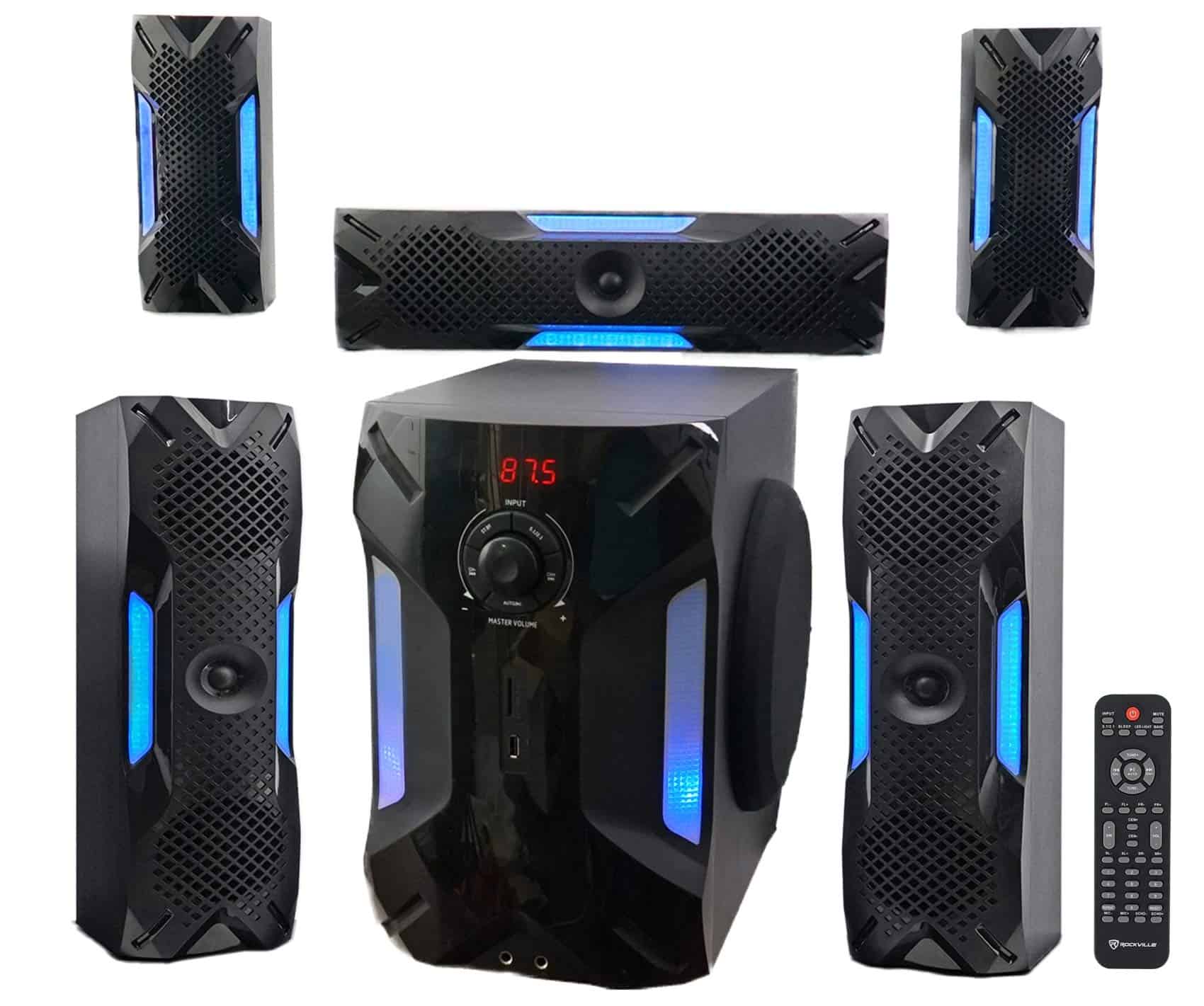
The Rockville HTS56 offers impressive sound quality and features at a budget-friendly price point, making it a solid choice for anyone wanting to upgrade their home entertainment setup.
Pros
- Powerful 1000W peak output with clear sound even at high volumes
- Multiple connectivity options including Bluetooth, USB, and optical input
- Customizable LED lighting effects add visual appeal
Cons
- Some units develop sound issues after months of use
- Larger setup than a soundbar requires more space
- Remote control feels somewhat basic
We recently tested the Rockville HTS56 home theater system and were impressed by its performance right out of the box. Setup was straightforward – we connected the 8″ subwoofer (which houses the receiver) to our TV using the optical input, then placed the five satellite speakers around our living room. The front and center channel speakers delivered crisp dialogue while the rear speakers created convincing surround effects.
The sound quality surprised us for a system at this price point. Bass from the subwoofer was deep and powerful without overwhelming the mix. We cranked up the volume during an action movie scene and noticed minimal distortion even at higher levels. The system also performed well with music, providing good separation between instruments and vocals.
One feature we particularly enjoyed was the customizable LED lighting. The subwoofer offers four lighting modes with seven color options that can pulse to the beat of your music. This adds a fun visual element for parties or gaming sessions. The Bluetooth connectivity worked reliably up to about 30 feet, and we appreciated having USB and SD card inputs for playing digital music files directly.
The independent volume controls for each speaker allowed us to fine-tune the sound balance for our specific room layout. For karaoke fans, the microphone inputs with echo function are a nice bonus. While not as compact as a soundbar system, the Rockville offers significantly better sound separation and true surround sound effects that make movies much more immersive.
| Feature | Specification |
|---|---|
| Power Output | 1000W Peak / 250W RMS |
| Speaker Configuration | 5.1 Channel (8″ Sub + 5 Satellite Speakers) |
| Connectivity | Bluetooth, USB, SD, Optical, RCA inputs |
| Special Features | LED Lighting, FM Radio, Karaoke Function |
| Speaker Cable Length | Front: 12ft, Rear: 30ft, Center: 10ft |
Yamaha YHT-5960U Home Theater System

The Yamaha YHT-5960U delivers impressive surround sound with modern features that make it a solid choice for most home theater enthusiasts.
Pros
- Rich, clear audio that fills the room
- Future-proof with 8K/4K HDMI 2.1 connections
- Auto-calibration adjusts to your room’s acoustics
Cons
- Included speakers might not satisfy audiophiles
- Setup can be challenging for beginners
- 80-watt power rating is modest for larger rooms
We recently set up the Yamaha YHT-5960U in our media room, and the difference was immediately noticeable. The 5.1-channel system creates an immersive sound bubble that made movie night much more exciting. Action scenes felt more impactful, and even quieter dialogue came through clearly.
The system works well right out of the box, but we recommend spending some time with the YPAO calibration feature. This smart technology uses a microphone to analyze your room’s acoustics and adjusts the sound accordingly. It took about five minutes to complete, but the improvement in sound quality was worth it.
Gamers will appreciate the HDMI 2.1 ports that support enhanced gaming features like Variable Refresh Rate (VRR) and Auto Low Latency Mode (ALLM). We tested a few fast-paced games, and the system kept up without any noticeable lag or audio sync issues. The ability to pass through 8K signals also means this system won’t need replacing when you upgrade your TV.
Connection options are plentiful with this system. We easily linked our turntable, streaming devices, and game console. The MusicCast feature lets you stream music wirelessly from your phone, which came in handy during a recent gathering. Sound quality for music is good but not outstanding—the system clearly performs better with movie soundtracks than complex musical arrangements.
| Feature | Specification |
|---|---|
| Channels | 5.1 |
| Power Output | 80 Watts per channel |
| HDMI Ports | 4 in, 1 out (HDMI 2.1) |
| Room Calibration | YPAO automatic |
| Video Support | 8K60B, 4K120AB, Dolby Vision |
| Weight | 53.9 pounds |
The subwoofer provides decent bass response that you can feel during explosive movie scenes. While it won’t rattle your windows, it adds enough depth to create a well-rounded listening experience. The satellite speakers are compact enough to fit on shelves or mount on walls without dominating your room’s decor.
Sony HT-S40R Soundbar System
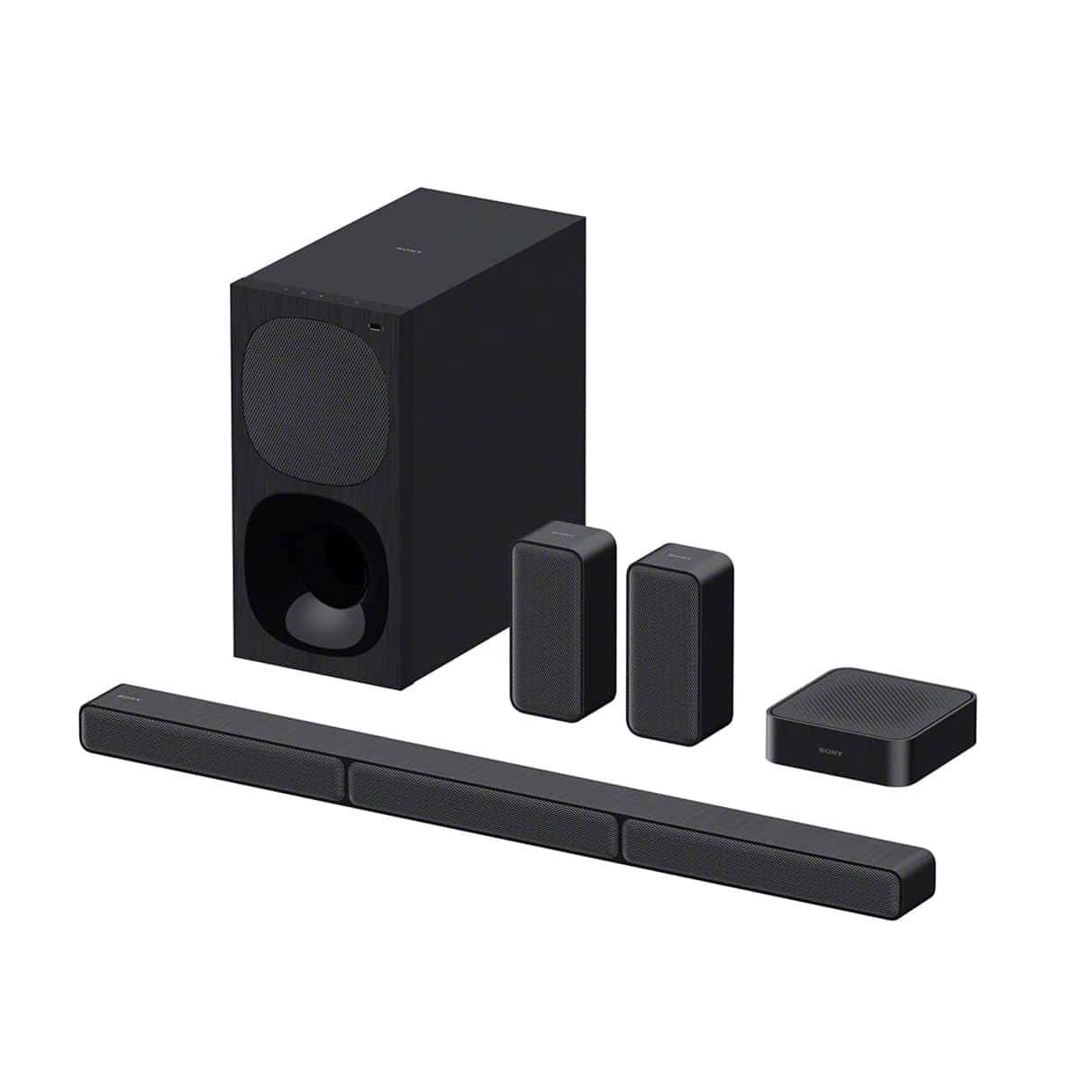
The Sony HT-S40R delivers impressive surround sound for its price point, offering a convenient way to upgrade your home theater without breaking the bank.
Pros
- Powerful 600W output with deep bass response
- True 5.1 channel surround with wireless rear speakers
- Simple color-coded setup process
Cons
- Some users report random popping sounds
- Requires high volume settings to match TV speakers
- Mixed reliability based on customer experiences
I recently set up the Sony HT-S40R in my living room, and the difference was immediate. The 600W of power creates an immersive soundscape that makes action scenes come alive. During intense movie moments, the subwoofer delivers room-filling bass that you can actually feel.
The wireless rear speakers were surprisingly easy to position. They connect to a small amplifier unit that only needs power – no messy cables running across the room. We placed them on the included stands about 6 feet behind our couch. The separation between front and rear channels creates a genuine surround sound bubble.
Connection options are plentiful with HDMI, optical, and analog inputs available. We used the HDMI ARC connection which lets us control everything with our TV remote. The Bluetooth feature works well for streaming music from phones too, though there’s occasionally a slight delay when first connecting.
The sound quality is impressive for this price bracket. Dialog comes through clearly on the center channel, while the dedicated sound modes make a noticeable difference between movies and music. The night mode feature reduces bass and enhances speech – perfect for late-night viewing without disturbing others.
Setup took less than 30 minutes including unpacking. The color-coded cables eliminate confusion, making this ideal for anyone intimidated by complex audio systems. The subwoofer paired automatically with the soundbar, and the remote gives easy access to all the essential controls.
| Feature | Details |
|---|---|
| Power Output | 600W total |
| Audio Channels | 5.1 surround sound |
| Connectivity | HDMI, Optical, Analog, Bluetooth |
| Subwoofer | Wireless |
| Special Features | Sound modes, Dialog enhancement |
| Dimensions | 13.66″D x 33.22″W x 9.76″H |
Klipsch Reference 5.2 Home Theater System
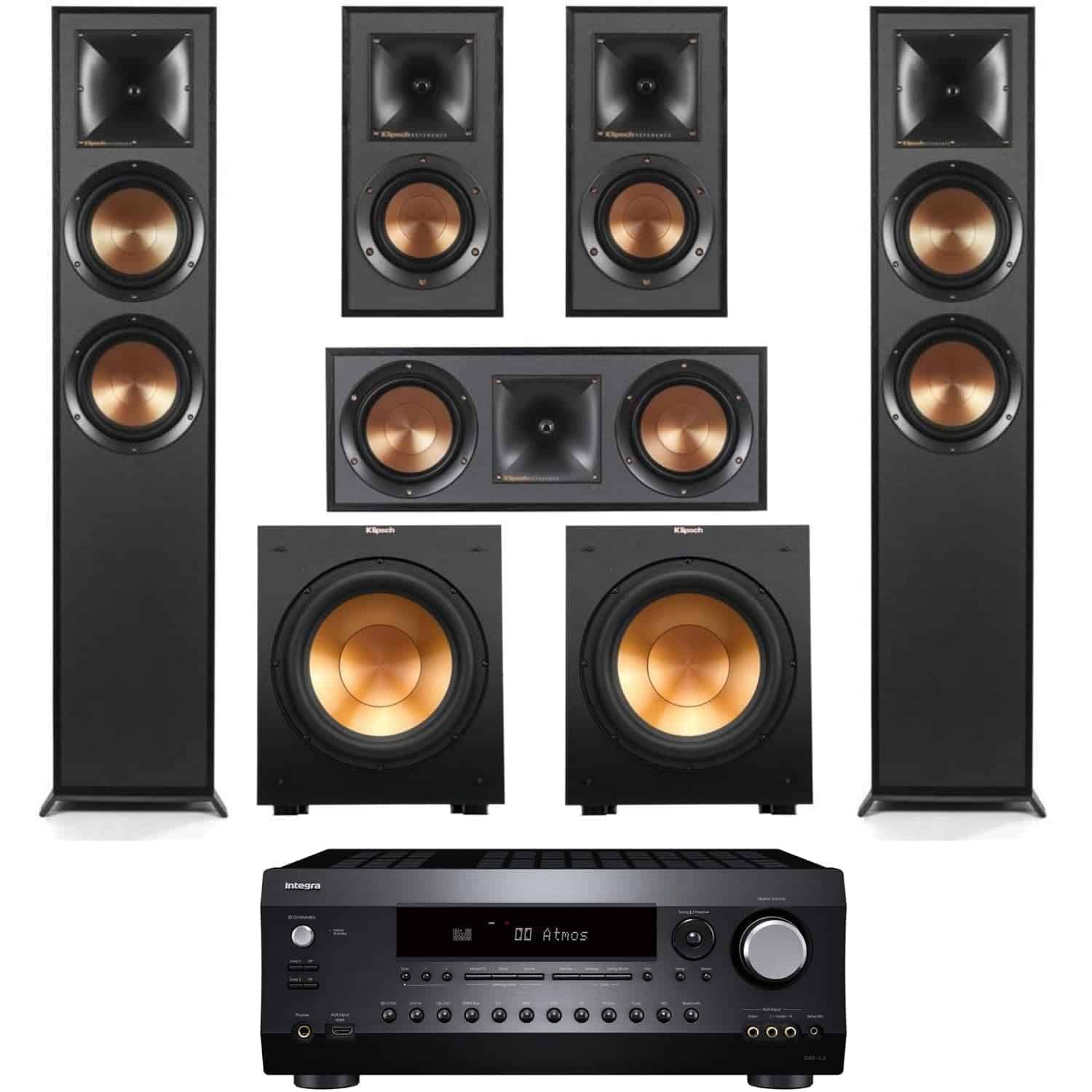
This complete Klipsch home theater package delivers exceptional sound quality and value that will transform any living room into a cinema-like experience.
Pros
- Powerful, room-filling sound with impressive clarity
- Complete system with matching components
- Built-in Dolby Atmos technology in floorstanding speakers
Cons
- Requires significant floor space
- Setup can be complex for beginners
- Some additional speaker wire needed
We recently set up this Klipsch Reference home theater system in our testing room, and the difference was immediate. The two R-625FA floorstanding speakers create a wide soundstage that filled the room completely. Their built-in Dolby Atmos technology adds height to movie soundtracks, making explosions, rain, and overhead aircraft sound incredibly realistic.
The center channel speaker deserves special praise. Dialogue comes through crystal clear even during loud action scenes. We could understand every whispered conversation without needing to adjust the volume. The R-41M bookshelf speakers handle the surround effects perfectly, despite their compact size.
Bass response from the dual 12-inch subwoofers is nothing short of impressive. These aren’t one-note wonders – they provide deep, controlled bass that you can feel in your chest. During our testing, the floor actually vibrated during certain movie scenes, yet music still sounded balanced and natural. The Integra receiver ties everything together with plenty of power and processing options.
Setup takes some time and patience. The system doesn’t come with speaker wire, so budget for that additional purchase. We needed to play with speaker placement to get the best sound, particularly with the subwoofers. Once positioned correctly, the system creates a cohesive soundfield that’s hard to beat at this price point.
Buying Guide
Choosing a home theater system can feel overwhelming. With so many options available, it’s helpful to know what to look for before you buy.
Budget Considerations
Your budget will guide many of your decisions. Home theater systems range from a few hundred dollars to several thousand.
| Price Range | What to Expect |
|---|---|
| $200-500 | Basic soundbar or 5.1 speaker set with limited features |
| $500-1000 | Mid-range receiver with decent speakers, more connection options |
| $1000-2500 | Quality receiver, good speaker set, possibly 4K support |
| $2500+ | Premium components, advanced audio formats, full 4K/HDR support |
Room Size and Layout
The size of your room matters a lot. Larger rooms need more powerful systems to fill the space with sound.
We recommend measuring your room before shopping. Note the distance from where you’ll sit to where the TV and speakers will go.
Audio Formats
Look for systems that support modern audio formats like Dolby Atmos and DTS for the most immersive experience.
Speaker Configuration
- 2.1 system: Two speakers plus subwoofer – good for small spaces
- 5.1 system: Five speakers plus subwoofer – standard surround sound
- 7.1 system: Seven speakers plus subwoofer – enhanced surround
- 7.1.2 or more: Adds height channels for 3D sound (Atmos/DTS)
Connectivity Options
Make sure your system has enough HDMI inputs for all your devices. Look for HDMI 2.1 if you plan to connect next-gen gaming consoles.
Wireless connectivity like Bluetooth and Wi-Fi lets you stream music easily from your phone or other devices.
Future-Proofing
We suggest choosing a system that will last several years. Look for 4K passthrough, HDR support, and upgradeable firmware.
Frequently Asked Questions
Home theater systems can be complex. Here are answers to common questions that will help you make smart choices about surround sound, brands, wireless options, and more.
What components are essential for the best home theater surround sound experience?
A complete home theater surround sound system needs several key components. You’ll need a good AV receiver that processes audio signals and powers your speakers.
A standard 5.1 speaker system includes front left and right speakers, a center channel for dialogue, two surround speakers, and a subwoofer for bass. Some systems now offer 7.1 or 9.2 configurations for more immersive sound.
Quality speaker wire ensures proper signal transmission between components. Don’t forget HDMI cables to connect video sources to your receiver and TV.
How do home theater systems from Sony compare to those from Bose in terms of audio quality?
Sony home theater systems typically offer excellent value with balanced sound profiles and good bass response. Their systems often include more connection options and support for multiple audio formats.
Bose systems are known for rich, room-filling sound from smaller speakers. They excel in clarity and often feature proprietary technology that creates immersive sound from fewer speakers.
Sony generally provides more customization options while Bose delivers a more plug-and-play experience. Price points differ too, with Bose usually commanding premium prices for their simplified setups.
What are the advantages of a wireless home theater system over a wired one?
Wireless systems offer much cleaner installation with no speaker wires running across your floor or walls. This makes them perfect for rooms where hiding cables is difficult.
Setup is typically faster and easier since you don’t need to measure and cut speaker wire. Many wireless systems use Bluetooth or Wi-Fi for audio streaming from multiple devices.
The main drawbacks include potential signal interference, the need for power outlets near each speaker, and sometimes slightly higher latency compared to wired connections.
What are the top-rated home theater systems currently on the market?
| Brand & Model | Key Features | Price Range |
|---|---|---|
| Sonos Arc 5.1 | Wireless, voice control, expandable | $1,500-1,800 |
| Klipsch Reference Theater Pack | Compact design, powerful sound | $700-900 |
| Nakamichi Shockwafe Ultra | 9.2.4 channels, Dolby Atmos support | $1,000-1,300 |
| Denon DHT-S716H | HEOS multi-room audio, 4K pass-through | $800-1,000 |
| JBL Bar 9.1 | Detachable wireless rear speakers, Atmos | $900-1,100 |
The Sonos Arc system offers excellent sound quality with simple setup and multi-room capabilities. Klipsch delivers big sound from small speakers at a more affordable price point.
Nakamichi’s system provides theater-quality audio with multiple subwoofers for serious home theater enthusiasts.
How can I integrate a projector into my home theater setup for an optimal viewing experience?
Choose a projector with at least 1080p resolution (4K is better) and sufficient brightness (measured in lumens) for your room. Darker rooms need fewer lumens, while brighter rooms require more.
Install your projector at the proper distance from your screen based on the throw ratio. Most projectors include calculators to help determine optimal placement.
Connect your projector to your AV receiver via HDMI, ensuring it supports the same resolution as your projector. Consider a ceiling mount for the cleanest installation and to prevent people walking through the projection path.
What should I consider when choosing between a home theater system and a soundbar?
Space is a major factor. Traditional home theater systems require room for multiple speakers and wiring, while soundbars take up minimal space.
Budget matters too. Quality soundbars range from $200-800, while complete theater systems typically start around $500 and can exceed $2,000.
Consider your priority for sound quality versus convenience. Home theater systems deliver better surround sound separation and usually more powerful bass, but soundbars offer simpler setup and operation.
Your room’s acoustics also play a role. Smaller rooms may benefit more from a good soundbar, while larger spaces can showcase the advantages of a full surround system.
